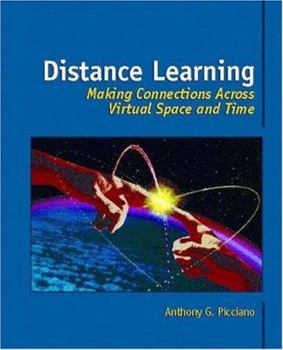Distance Learning: Making Connections Across Virtual Space and Time
The book provides both solid theory and practical considerations for the planning and implementing of distance learning programs. It presents the fundamental concepts of distance learning, planning... This description may be from another edition of this product.
Format:Paperback
Language:English
ISBN:0130809004
ISBN13:9780130809001
Release Date:January 2000
Publisher:Prentice Hall
Length:253 Pages
Weight:1.00 lbs.
Dimensions:0.5" x 7.6" x 9.2"
Related Subjects
Computers & Technology Education Education & Reference Schools & Teaching TextbooksCustomer Reviews
1 rating
Distance Learning
Published by Thriftbooks.com User , 24 years ago
Distance Learning: Making Connections Across Virtual Space and Time, by Anthony G. Picciano offers insight and guidance for all the faculty and administrators who need to plan and implement distance learning curriculum. Picciano, provides an academic outline for distance learning programs and specializes in educational technology, organization theory, and research methods. This text provides guidance for planning and implementing distance learning programs. Picciano welcomes the reader by defining distance learning as a vehicle to overcome the physical separation of teacher and students due to geography obstructions in an educational process. The author illustrates the fundamental concepts of distance learning, planning, program development, and the basic technologies used for his intended audience of administrators, managers, teachers, distance learning coordinators, chief information officers, and media specialists. Anyone involved in initiating and developing distance-learning programs will find this book beneficial. Picciano identifies planning as one of the most important issues dealing with distance education. In designing and developing new distance learning programs, additional consideration is necessary as to the goals and objectives of academic programs, hardware, software, facilities, staff development, student demands, curriculum integration, and finances. Evaluations need to be an on-going process in established distance-learning programs, including new digital technologies, and modernized alternatives. The author explains that planning should occur in all educational organizations and may be formal or informal. He outlines how educational organizations will function in the future and how they should prepare accordingly. Picciano highlights that the most effective type of planning for any educational organization is to make faculty and staff aware of the plan and the actions necessary for achieving important benchmarks. Picciano recommends an inclusive and participatory approach. Faculty, support staff and other administrators must be involved with the planning stage, in starting a new program, or expanding or modifying an existing distance learning program for it to be successful. According to Picciano, the four major elements of successful planning include comprehensiveness, collaboration, commitment, and continuity. The planning process is continuous, as technology and society changes, so must the plan. Developing a written plan guides everyday activities, and must be updated when necessary. Picciano's model for planning for distance learning includes the college, the governing board, and the environment with respect to cultural values, goals, applications, hardware, evaluation and feedback. This model teaches the development, uses, goals, and objectives for planning a distance-learning curriculum. Distance learning is dependent upon technology for delivering the instruction and as technology changes, so must the approved writt






